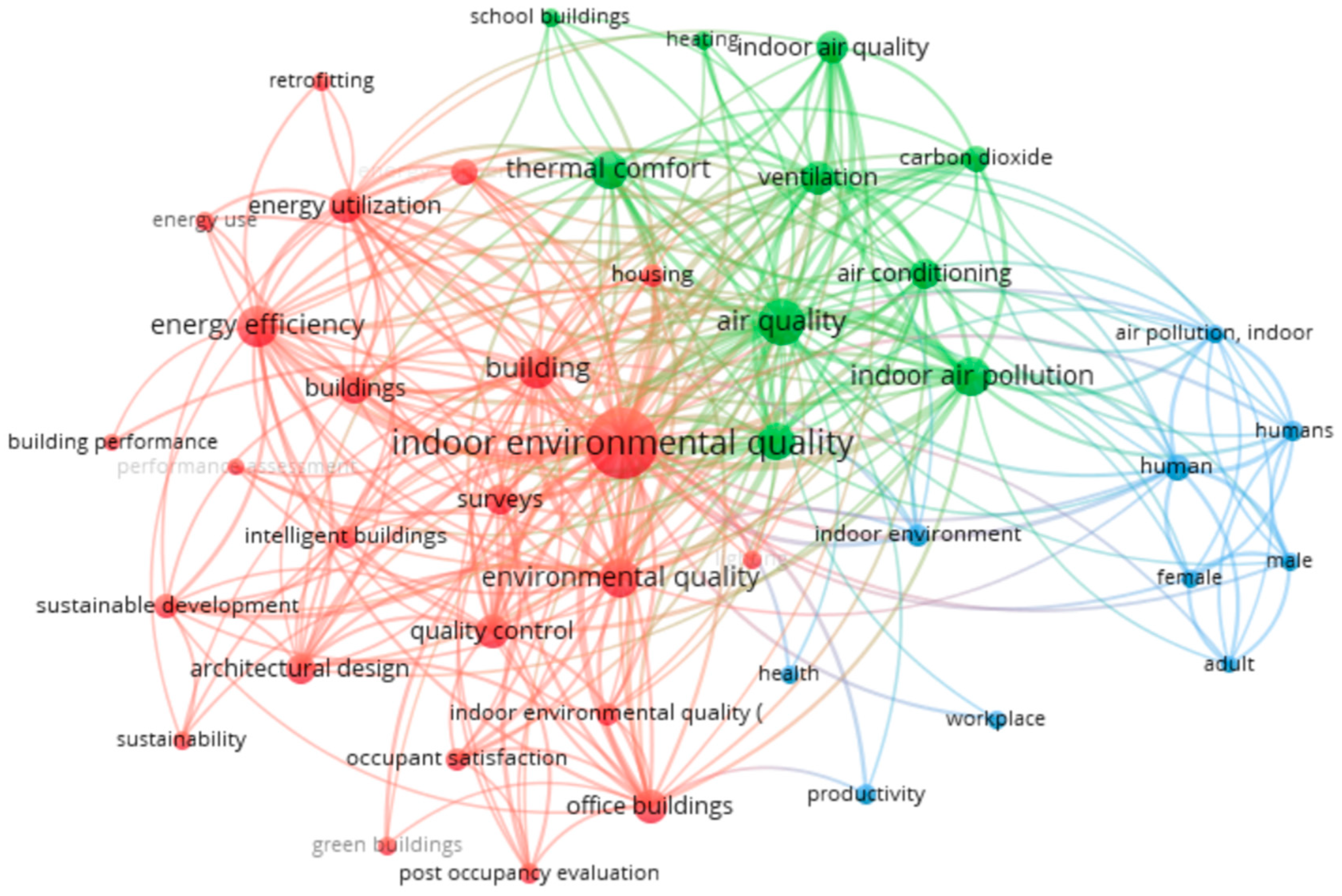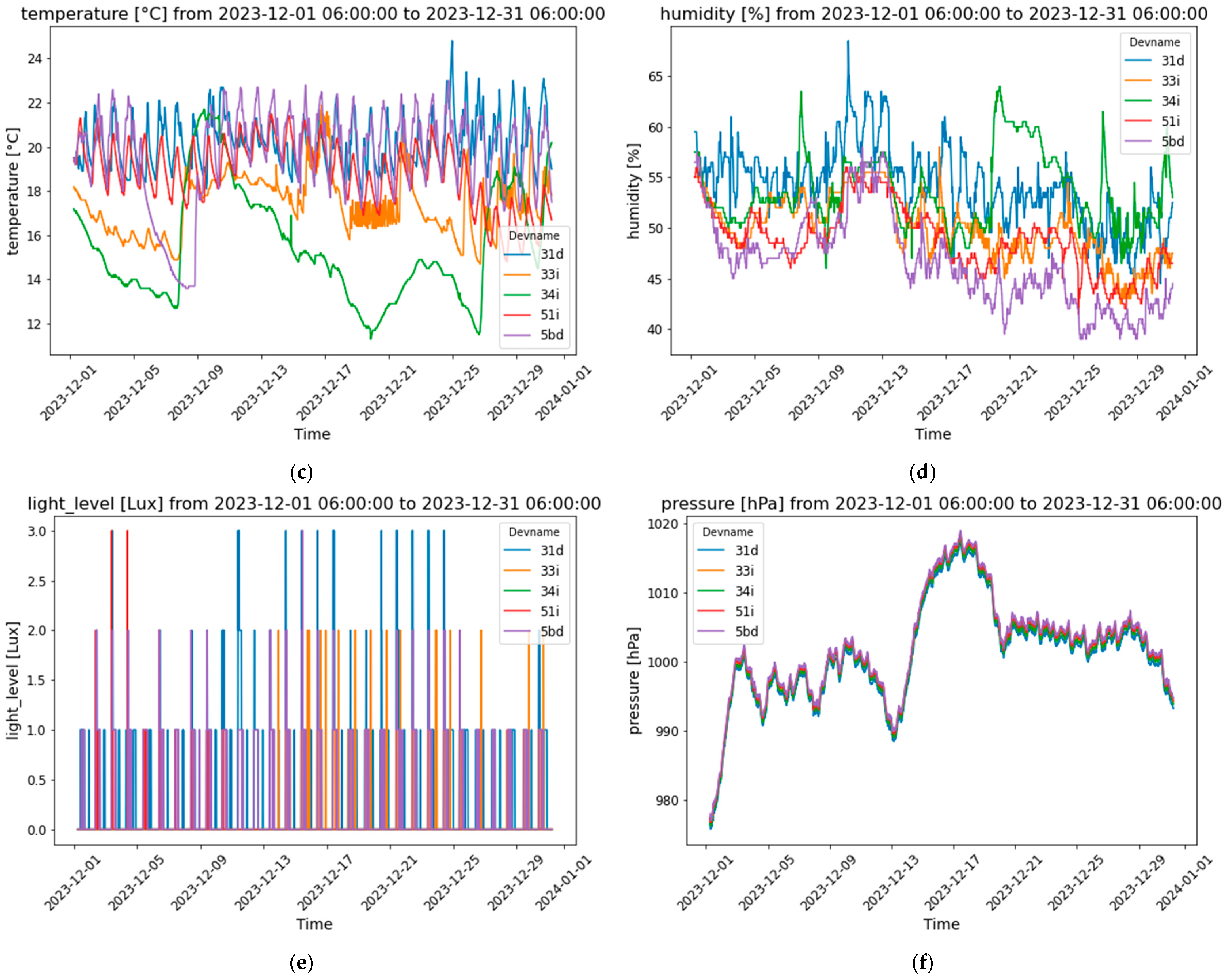Dynamic Indoor Environmental Quality Assessment in Residential Buildings: Real-Time Monitoring of Comfort Parameters Using LoRaWAN
Abstract
:1. Introduction
1.1. Background: Building Comfort
1.2. State of the Art: Building Comfort
1.3. Scope and Objectives: Buildings’ Environmental Quality
2. Materials and Methods
3. Results
3.1. Indoor Environmental Parameters Evolution in a Short Period
3.2. Indoor Environmental Parameters over Time
4. Conclusions
Author Contributions
Funding
Data Availability Statement
Conflicts of Interest
References
- Wyon, D.P. The effects of indoor air quality on performance and productivity. Indoor Air Suppl. 2004, 14 (Suppl. 7), 92–101. [Google Scholar] [CrossRef] [PubMed]
- Fisk, W.J.; Black, D.; Brunner, G. Benefits and costs of improved IEQ in U.S. offices. Indoor Air 2011, 21, 357–367. [Google Scholar] [CrossRef] [PubMed]
- Dorizas, P.V.; Assimakopoulos, M.-N.; Santamouris, M. A holistic approach for the assessment of the indoor environmental quality, student productivity, and energy consumption in primary schools. Environ. Monit. Assess. 2015, 187, 259. [Google Scholar] [CrossRef] [PubMed]
- Sakellaris, I.A.; Saraga, D.E.; Mandin, C.; Roda, C.; Fossati, S.; De Kluizenaar, Y.; Carrer, P.; Dimitroulopoulou, S.; Mihucz, V.G.; Szigeti, T.; et al. Perceived indoor environment and occupants’ comfort in European ‘Modern’ office buildings: The OFFICAIR Study. Int. J. Environ. Res. Public Health 2016, 13, 444. [Google Scholar] [CrossRef] [PubMed]
- Subri, M.S.M.; Arifin, K.; Sohaimin, M.F.A.M.; Abas, A. The parameter of the Sick Building Syndrome: A systematic literature review. Heliyon 2024, 10, e32431. [Google Scholar] [CrossRef]
- Felgueiras, F.; Mourão, Z.; Moreira, A.; Gabriel, M.F. Indoor environmental quality in offices and risk of health and productivity complaints at work: A literature review. J. Hazard. Mater. Adv. 2023, 10, 100314. [Google Scholar] [CrossRef]
- Lolli, F.; Coruzzolo, A.M.; Balugani, E. The Indoor Environmental Quality: A TOPSIS-based approach with indirect elicitation of criteria weights. Saf. Sci. 2022, 148, 105652. [Google Scholar] [CrossRef]
- Martínez-Comesaña, M.; Eguía-Oller, P.; Martínez-Torres, J.; Febrero-Garrido, L.; Granada-Álvarez, E. Optimisation of thermal comfort and indoor air quality estimations applied to in-use buildings combining NSGA-III and XGBoost. Sustain. Cities Soc. 2022, 80, 103723. [Google Scholar] [CrossRef]
- Liu, F.; Chang-Richards, A.; Wang, K.I.-K.; Dirks, K.N. Critical indoor environmental factors affecting productivity: Perspectives from university staff and postgraduate students. Build. Res. Inf. 2023, 51, 730–745. [Google Scholar] [CrossRef]
- Bianco, L.; Serra, V.; Fantucci, S.; Dutto, M.; Massolino, M. Thermal insulating plaster as a solution for refurbishing historic building envelopes: First experimental results. Energy Build. 2015, 95, 86–91. [Google Scholar] [CrossRef]
- Phillips, T.J.; Levin, H. Indoor environmental quality research needs for low-energy homes. Sci. Technol. Built Environ. 2015, 21, 80–90. [Google Scholar] [CrossRef]
- Serrano-Jiménez, A.; Lizana, J.; Molina-Huelva, M.; Barrios-Padura, Á. Indoor environmental quality in social housing with elderly occupants in Spain: Measurement results and retrofit opportunities. J. Build. Eng. 2020, 30, 101264. [Google Scholar] [CrossRef]
- Broday, E.E.; da Silva, M.C.G. The role of internet of things (IoT) in the assessment and communication of indoor environmental quality (IEQ) in buildings: A review. Smart Sustain. Built Environ. 2023, 12, 584–606. [Google Scholar] [CrossRef]
- Abdel-Razek, S.A.; Marie, H.S.; Alshehri, A.; Elzeki, O.M. Energy Efficiency through the Implementation of an AI Model to Predict Room Occupancy Based on Thermal Comfort Parameters. Sustainability 2022, 14, 7734. [Google Scholar] [CrossRef]
- Fan, Y.; Ito, K. Optimization of indoor environmental quality and ventilation load in office space by multilevel coupling of building energy simulation and computational fluid dynamics. Build. Simul. 2014, 7, 649–659. [Google Scholar] [CrossRef]
- European Union. DIRECTIVE (EU) 2018/844 of the European Parliament and of the Council. May 2018. Available online: https://environment.ec.europa.eu/publications/levels-and-european-climate-pact_en (accessed on 17 September 2024).
- REHVA. European Framework for Sustainable Buildings. Available online: www.rehva.eu (accessed on 17 September 2024).
- Salamone, F.; Belussi, L.; Danza, L.; Galanos, T.; Ghellere, M.; Meroni, I. Design and development of a nearablewireless system to control indoor air quality and indoor lighting quality. Sensors 2017, 17, 1021. [Google Scholar] [CrossRef]
- Piasecki, M.; Kostyrko, K.; Pykacz, S. Indoor environmental quality assessment: Part 1: Choice of the indoor environmental quality sub-component models. J. Build. Phys. 2017, 41, 264–289. [Google Scholar] [CrossRef]
- Dorsey, J.; Hedge, A. Re-evaluation of a LEED Platinum Building: Occupant experiences of health and comfort. Work 2017, 57, 31–41. [Google Scholar] [CrossRef]
- Candido, C.; Marzban, S.; Haddad, S.; Mackey, M.; Loder, A. Designing healthy workspaces: Results from Australian certified open-plan offices. Facilities 2021, 39, 411–433. [Google Scholar] [CrossRef]
- Himeur, Y.; Elnour, M.; Fadli, F.; Meskin, N.; Petri, I.; Rezgui, Y.; Bensaali, F.; Amira, A. AI-big data analytics for building automation and management systems: A survey, actual challenges and future perspectives. Artif. Intell. Rev. 2023, 56, 4929–5021. [Google Scholar] [CrossRef]
- Elnour, M.; Himeur, Y.; Fadli, F.; Mohammedsherif, H.; Meskin, N.; Ahmad, A.M.; Petri, I.; Rezgui, Y.; Hodorog, A. Neural network-based model predictive control system for optimizing building automation and management systems of sports facilities. Appl. Energy 2022, 318, 119153. [Google Scholar] [CrossRef]
- Haleem, S.M.A.; Pavlak, G.S.; Bahnfleth, W.P. Performance of advanced control sequences in handling uncertainty in energy use and indoor environmental quality using uncertainty and sensitivity analysis for control components. Energy Build. 2020, 225, 110308. [Google Scholar] [CrossRef]
- Pasetti, M.; Ferrari, P.; Silva, D.R.C.; Silva, I.; Sisinni, E. On the use of LoRaWAN for the monitoring and control of distributed energy resources in a smart campus. Appl. Sci. 2020, 10, 320. [Google Scholar] [CrossRef]
- Piechowiak, M.; Zwierzykowski, P.; Musznicki, B. LoRaWAN Metering Infrastructure Planning in Smart Cities. Appl. Sci. 2023, 13, 8431. [Google Scholar] [CrossRef]
- Mselle, B.D.; Zsembinszki, G.; Borri, E.; Vérez, D.; Cabeza, L.F. Trends and future perspectives on the integration of phase change materials in heat exchangers. J. Energy Storage 2021, 38, 102544. [Google Scholar] [CrossRef]
- ASHRAE Committee. ASHRAE Position Document on Indoor Carbon Dioxide; ASHRAE: Atlanta, GA, USA, 2022. [Google Scholar]
- US EPA. The Inside Story: A Guide to Indoor Air Quality; US EPA: Washington, DC, USA, 1993. [Google Scholar]
- Attune. Comprehensive Guide to Indoor Air Quality Parameters. Available online: https://www.attuneiot.com/resources/iaq-parameters-guide (accessed on 29 August 2024).
- Samad, A. A Comparative Study on Emerging Radio Technologies for IoT. 2020. Available online: www.preprints.org (accessed on 11 September 2024).
- Mekki, K.; Bajic, E.; Chaxel, F.; Meyer, F. A comparative study of LPWAN technologies for large-scale IoT deployment. ICT Express 2017, 5, 1–7. [Google Scholar] [CrossRef]
- Milesight. User Guide: Indoor Ambience Monitoring Sensor. Featuring LoRaWAN. AM300 (L) Series. 2024. Available online: https://resource.milesight.com/milesight/iot/document/am300-series-user-guide-en.pdf (accessed on 11 October 2024).
- Skulberg, K.R.; Nyrud, A.Q.; Goffeng, L.O.; Wisthaler, A. Health and Exposure to VOCs From Pinewood in Indoor Environments. Front. Built Environ. 2019, 5, 107. [Google Scholar] [CrossRef]
- Antonelli, M.; Donelli, D.; Barbieri, G.; Valussi, M.; Maggini, V.; Firenzuoli, F. Forest volatile organic compounds and their effects on human health: A state-of-the-art review. Int. J. Environ. Res. Public Health 2020, 17, 6506. [Google Scholar] [CrossRef]






| Sensor | Model | Site | Description | Parameter | Units | Accuracy | Time Gap |
|---|---|---|---|---|---|---|---|
| Milesight | AM307 | Living room | Indoor Ambiance Sensor | CO2 | ppm | ±50 | 15 min |
| TVOC | μg/m3 | 0.01 | |||||
| Temperature | °C | 0.1 °C | |||||
| Humidity | % | 0.5% | |||||
| Illuminance | lux | 00: 0–5 lux 01: 6–50 lux 02: 51–100 lux 03: 101–500 lux 04: 501–2000 lux 05: >2000 lux | |||||
| Atmospheric pressure | hPa | 0.1 hPa |
Disclaimer/Publisher’s Note: The statements, opinions and data contained in all publications are solely those of the individual author(s) and contributor(s) and not of MDPI and/or the editor(s). MDPI and/or the editor(s) disclaim responsibility for any injury to people or property resulting from any ideas, methods, instructions or products referred to in the content. |
© 2024 by the authors. Licensee MDPI, Basel, Switzerland. This article is an open access article distributed under the terms and conditions of the Creative Commons Attribution (CC BY) license (https://creativecommons.org/licenses/by/4.0/).
Share and Cite
Longares, J.M.; Mselle, B.D.; Gutierrez Galindo, J.I.; Ballestin, V. Dynamic Indoor Environmental Quality Assessment in Residential Buildings: Real-Time Monitoring of Comfort Parameters Using LoRaWAN. Energies 2024, 17, 5534. https://doi.org/10.3390/en17225534
Longares JM, Mselle BD, Gutierrez Galindo JI, Ballestin V. Dynamic Indoor Environmental Quality Assessment in Residential Buildings: Real-Time Monitoring of Comfort Parameters Using LoRaWAN. Energies. 2024; 17(22):5534. https://doi.org/10.3390/en17225534
Chicago/Turabian StyleLongares, Jose Manuel, Boniface Dominick Mselle, Jose Ignacio Gutierrez Galindo, and Victor Ballestin. 2024. "Dynamic Indoor Environmental Quality Assessment in Residential Buildings: Real-Time Monitoring of Comfort Parameters Using LoRaWAN" Energies 17, no. 22: 5534. https://doi.org/10.3390/en17225534
APA StyleLongares, J. M., Mselle, B. D., Gutierrez Galindo, J. I., & Ballestin, V. (2024). Dynamic Indoor Environmental Quality Assessment in Residential Buildings: Real-Time Monitoring of Comfort Parameters Using LoRaWAN. Energies, 17(22), 5534. https://doi.org/10.3390/en17225534







